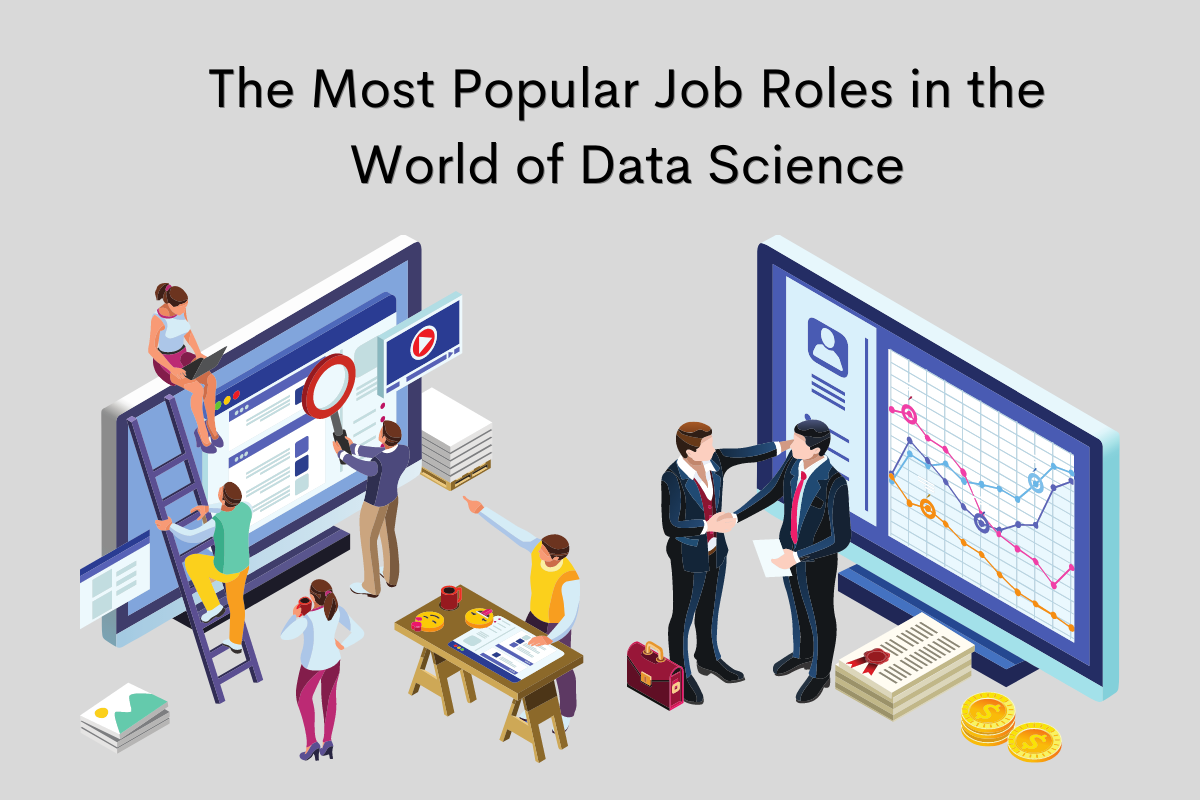The Most Popular Job Roles in the World of Data Science

Categories:
 Written by:
Written by:Nazlican Kurt
Understand the various data science roles and what kind of data scientist job role you should be in.
We are in the midst of a major change and transformation process, in which smart businesses see data as critical to their future success and adapt their organizations accordingly.
On the other hand, the human resource requirements of organizations undergoing this change are pretty varied. We can easily say that this human resource problem is at the forefront of the issues that the data analytics program has dealt with and successfully solved.
If you’ve mastered the fundamentals, I’m sure you’re eager to learn more, so consider a career in machine learning or data science. When making this decision, think about what you enjoy doing and what subjects you can concentrate on for a long time without losing interest. If you’re just starting out, check out our comprehensive guide on how to become a data scientist from scratch that will take you through every necessary step to become a successful data scientist.
As an example, I’m going to write out some subjects and job opportunities you should be aware of. These keywords are not all-encompassing, but you can search for what’s available.
Opportunities to work in Data Science Jobs
Data science can be integrated with almost all fields. As a data scientist, you can work in a wide variety of fields, including:
- Finance
- Academy
- Scientific Research
- Health
- Retail
- Information Technology
- Government
- E-commerce
So, what kind of data science role should we be in? Here are the prominent data science roles you should know:
The Different Data Science Roles in the Industry

1. Data Scientist
Data scientist; It is a person who can make information-oriented discoveries, define the current situation of the environment, is a classifier, and can make future predictions about the situation using the software. Describes the data at hand by using different tools. Makes inferences about the work done. Makes predictive, and preventive modeling.
The following are the data scientist roles and responsibilities, which include extracting usable information from the data:
- Knowing where to get the data and making data analysis,
- To solve the structure of the incoming data,
- To understand correctly what the data means,
- To detect deficiencies in the data,
- Shaping the data in line with the problem it wants to solve,
- To produce clustering and classifying solutions,
- Working using visualization techniques,
- To determine statistical research models,
- Developing hypotheses and making inferences,
- Using new analytical data in the software field.
We've provided a very specific and practical guide on how to get a data science job.
2. Data Architect
The world has now begun to be built on data, the ways of processing and distributing information have been reshaped with technology. In today’s world where new data are added to old data every minute, another data science role, data architects, undertake the task of creating systems that can select the right information from complex databases. Data architect creates database solutions for companies and institutions, designs data architecture. It determines how data will be stored, managed, and used by information system devices.
Among the other tasks of the data architecture, whose main task is to find the most effective systems for database systems, to create solutions, and to put them into practice by putting them into use;
- To produce database solutions for the storage of data of companies and institutions, to design and implement them,
- Determining the physical storage devices suitable for the database,
To do research on information systems that will increase efficiency, - Creating backup and storage strategies for problems that may occur in systems,
- To transfer the data in the old system to the new system in system changes,
- Creating data access methods according to business hierarchy,
- Making the analysis of the existing system, eliminating the deficiencies, providing a transition to new systems when necessary.
3. Business Analyst
Business Analyst is one of the prominent Data Science roles. A business analyst evaluates an institution's business processes, analyzes requirements, finds areas for improvement, and develops solutions. It identifies a project's or program's requirements and communicates them to management and partners. Its goal is to come up with technical solutions to business challenges or to help the company's sales efforts succeed.
The following are the tasks of the business analyst, who shows the connection between business and information technology:
- Analyzing company functions to set operational goals and acquire knowledge
- Developing flowcharts and diagrams
- Examining existing applications to develop systems and design modifications
- Putting together a project team and a budget
- Knowledge of advances in information technology to automate and modernize systems.
- Solving project problems and publishing progress reports,
- Preparing technical reports by collecting and analyzing information and trends,
- Making meetings and presentations to share ideas and analysis, etc.
To work as a business analyst, you should have a bachelor's degree in computer science, mathematics, industrial and business engineering, management information systems, or statistics.
4. Developer Advocate
Developer Advocacy is the data science role that explains the technology produced by a company to the relevant people. Let’s expand on these concepts a little more;
- To introduce the technologies that the company they work for is the developer or supporter of
- Preparing Articles/Blogs about these technologies
- Providing consultancy by identifying Common Uses for the technologies it is responsible for promoting
- Assisting the people or institutions that decide on the transition process to the technologies they are responsible for in the implementation process
- Answering questions and problems in the online platform about the technologies
- To increase the awareness of the product by making presentations and promotions at events and organizations about the technologies it is responsible for.
- Constantly following current and trending technologies and learning new technologies
5. Data Analyst
Data analyst is one of the most popular data science roles. With the advancement of technology, companies have begun to build their own databases. On their own, these numbers don’t make sense. You may remain ahead of your competition by transforming data into information in the direction you wish. The data analyst job role is to transform this data into information when you ask for it. Data becomes meaningful when it is processed to solve a problem or serve a specific purpose. The data analyst’s most fundamental task is to make the raw data meaningful.
The main tasks of data analysts needed in many sectors are as follows:
- To determine the analysis and measurement methods of the data,
- To make the data obtained from the measurements made more understandable,
- Researching the financial records of companies,
- Doing business with simple and useful solutions,
- To provide communication between corporate companies,
- Identifying business needs
- To produce solutions to meet the goals and objectives.
6. Machine Learning Engineer
Data Science is an interdisciplinary process. A Data Scientist role is to extract knowledge and insights from structured and unstructured data. Data Science relates to machine learning, data mining, and big data. — Wikipedia
According to Wikipedia, we can say that Machine learning is a branch of data science, as machine learning models learn from data.
In other words, machine learning engineers can make data meaningful with programming.
For machine learning engineers, the first and foremost requirement might be, which is well equipped on a programming language. Python is the most common language of “Machine Learning”. In the future, you probably need to learn all these languages like C++, R, Python, Java and work on MapReduce.
Here is the source about languages:
Python vs R: which language is better for a data science career?
There are many machine learning techniques. A solid understanding of algorithm theory and knowledge of topics such as Gradients, Convex Optimizations, Quadratic Programming, and Partial Differentiation will be very helpful. Keep calm and start with Python!
7. Algorithm Development Engineer
An algorithm development engineer is the data science role that includes the responsibility to design and develop desktop and mobile software systems within the scope of computer engineering. It is also responsible for keeping the software up to date.
- Identifying the qualities that consumers want in computer programs and developing solutions for them; To keep up with current procedures,
- Preparing and developing the designs needed in algorithms,
- Constantly updating algorithms,
- Taking measures to close security gaps,
- Writing code for various applications and editing these codes when necessary,
- Performing the necessary tests on the algorithms for which it is responsible,
- To provide essential in-service training to software specialists who have recently begun working at the institution, as well as to produce the necessary documents,
- To provide training and consultancy services to those who use the algorithms it has developed,
- Preparing user manuals and design documents, conveying the necessary instructions to the users.
8. Research Scientist & Research Engineer
There is no difference between a research scientist and a research engineer for some companies. First and last, research scientists should be engineers. Engineers and research scientists both come up with and develop strategies. A researcher may also serve as a consultant, advising research engineers on their own projects.
A research engineer’s job role is to utilize their technical talents to set up and execute experiments for these concepts, much as a research scientist’s job is to come up with unique ideas. A Ph.D. and/or first author papers at top-tier conferences are generally required for the research scientist position.
As a research engineer/scientist, you usually know to:
- Learning and using new ways to find answers, such as building mathematical models that interpret data in a meaningful way,
- Presents results to top management and at group and department meetings,
- During the course of a project, meets with partners to address ideas and outcomes.
- Clients are given instructions on how to accomplish it, to reap the benefits of mathematical analysis, and to offer recommendations based on these analyses
- Being able to manage a research team (or manage a group of research students in academic settings),
- Proposing new ways to analyze data as well as generating tailored solutions to business problems using innovative and existing methods,
- Sharing the results of new research by writing original articles for publication in peer-reviewed scientific journals, as well as preparing regular reports on the progress of the study
Final Thoughts
Your ability to quickly master the essential skills required to evaluate big data sets, as well as your dedication to the company with which you are working, will determine your progress. Junior data scientists may be promoted to higher-level data science roles within your organization, including line management. It might take two to five years to advance from junior to senior data scientist.
Being in a data science role, you’ll be expected to take on greater people management responsibilities after five years. It may be quite easy to move to different companies because the skills you learn are transferable across different industries. Joining a startup and working on projects outsourced by larger companies is another option. The things that will advance you in your data science career path are faith, patience, and hard work.
Share


